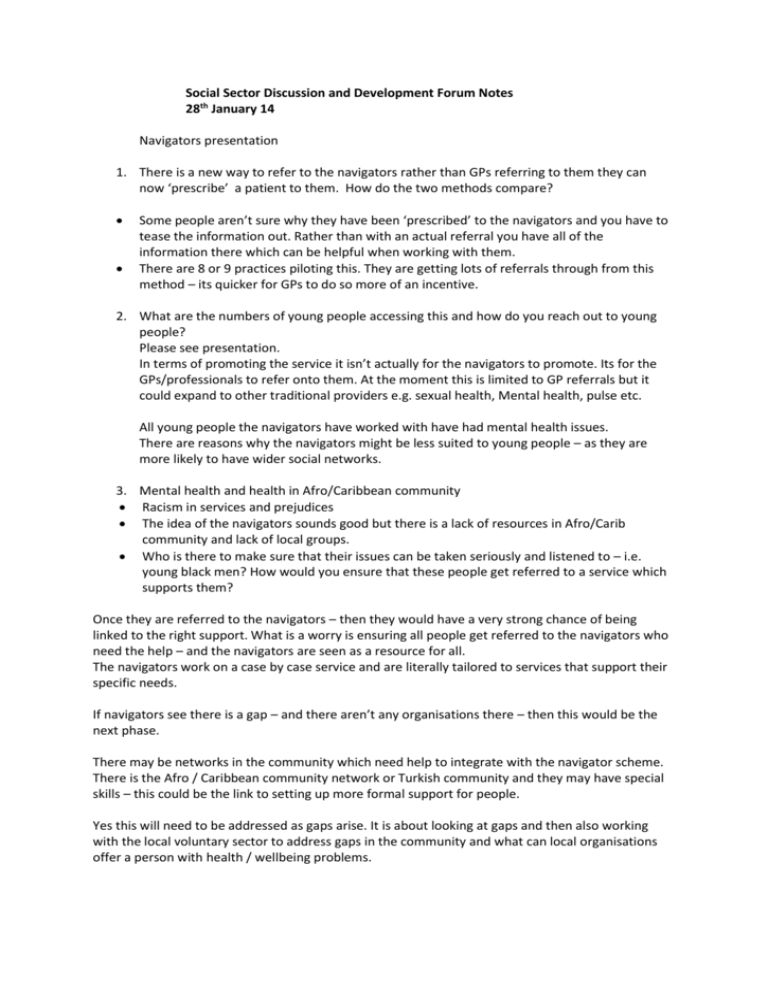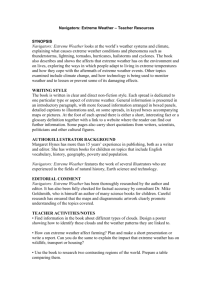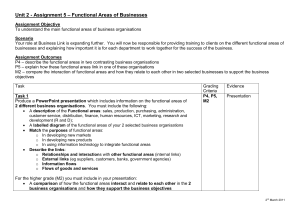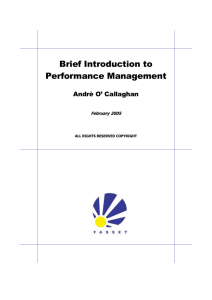Notes - Voluntary Action Islington
advertisement

Social Sector Discussion and Development Forum Notes 28th January 14 Navigators presentation 1. There is a new way to refer to the navigators rather than GPs referring to them they can now ‘prescribe’ a patient to them. How do the two methods compare? Some people aren’t sure why they have been ‘prescribed’ to the navigators and you have to tease the information out. Rather than with an actual referral you have all of the information there which can be helpful when working with them. There are 8 or 9 practices piloting this. They are getting lots of referrals through from this method – its quicker for GPs to do so more of an incentive. 2. What are the numbers of young people accessing this and how do you reach out to young people? Please see presentation. In terms of promoting the service it isn’t actually for the navigators to promote. Its for the GPs/professionals to refer onto them. At the moment this is limited to GP referrals but it could expand to other traditional providers e.g. sexual health, Mental health, pulse etc. All young people the navigators have worked with have had mental health issues. There are reasons why the navigators might be less suited to young people – as they are more likely to have wider social networks. 3. Mental health and health in Afro/Caribbean community Racism in services and prejudices The idea of the navigators sounds good but there is a lack of resources in Afro/Carib community and lack of local groups. Who is there to make sure that their issues can be taken seriously and listened to – i.e. young black men? How would you ensure that these people get referred to a service which supports them? Once they are referred to the navigators – then they would have a very strong chance of being linked to the right support. What is a worry is ensuring all people get referred to the navigators who need the help – and the navigators are seen as a resource for all. The navigators work on a case by case service and are literally tailored to services that support their specific needs. If navigators see there is a gap – and there aren’t any organisations there – then this would be the next phase. There may be networks in the community which need help to integrate with the navigator scheme. There is the Afro / Caribbean community network or Turkish community and they may have special skills – this could be the link to setting up more formal support for people. Yes this will need to be addressed as gaps arise. It is about looking at gaps and then also working with the local voluntary sector to address gaps in the community and what can local organisations offer a person with health / wellbeing problems. 4. What happens if you find there is no one to fill the gap e.g. no afro / Caribbean organisations? Talk to Voluntary action Islington to ensure mapping all organisations If there is a real sense of a consistent gap – then there would be a strong case to come to the CCG with a proposal. This would be a proposal to identify funding to develop this gap. One of the best things of the navigator roles is to identify these gaps. 5. It would be useful to begin to see the gaps and the needs published. Will the resources be linked to PHBs in some way? Is funding going to follow referral to these services? 6. What is the cost to the organisation of these referrals? Issue of funding is ultimately not for Age UK and navigator roles to decide. As with anything like this there would need to be a proposal to the CCG – this could potentially be a combined proposal. The investment and development must be linked to the pattern of demand. 1. Will it link to personal budgets? Yes, but it could also work the other way. In a way patient choice is about a range of services available whether the use personal budgets or not. There needs to be an understanding of an organisation and how it does its business, and the needs of the users put together. This type of work releases resources for funding in system e.g. community from hospital. It is about creating more opportunities to support people’s wellbeing in the community. Agenda: something on personal budgets. 2. Is there a danger that you may only work with bigger organisations? Because of their infrastructure they may seem better able to support this type of work. This is rather than a voluntary organisation that might not have. How can we evaluate all organisation’s work? Its not always big organisations that get the outcomes – users often prefer informality of local organisations and their understanding of key issues. There is real anxiety with small organisations. Bigger organisations could act as umbrella for littler organisations. They can: Provide support Cripplegate Small organisations can also work with navigators and the CCG would like to look at development sessions within these meetings to help aid smaller organisations present themselves. 3. There are organisations with links into the community but no health knowledge and no structure but real community knowledge. Small organisations need to retain a boundary, even if they work with bigger organisations. there are projects which can help – these are VAI skills education – to help develop data collection and use of data. The Navigators are trying to learn about organisations to refer people into. A shift needs to happen so an individual can demonstrate a shift in their quality of life. We need to look at creative ways which can capture and measure that by steering person into this service it has solved this amount for traditional services. 4. There is a worry that if cost cutting happens there will be more traditional services and the costly services which are resourced. We can look at Quantative and Qualitative i.e. on average GP visit and A&E visit after intervention, 3 month, 6 month and 12 months. Compare pre and post intervention. We can develop a template for voluntary organisations to help them collect this type of information. Navigators are keen to create a common denominator and language which can be used across systems. It can be hard to evidence preventative work which is what this is. Everyday language can be used so people can refer to these – as per the hand out sheets. The Self assessment form for services which were handed out - is not about a survey but a way to guide a discussion (and this is developing). It acts as a way of profiling what service offer is. It is helping people ‘making sense of what is out there.’ An issue highlighted with the exercise – is that someone is referred to a service. They may be able to help with anyone of the general outcomes. And so, it would depend on what the person’s needs are. I think people found evaluation a bit difficult – it is a flexible way of profiling the organisations. Is it just a new way of thinking? Need to develop people to think like this – it isn’t about organisations but patient outcomes. This is also developing GPs to think like that. Next steps: The navigators would really like to visit organisations to work through the outcomes guide – and ensure they are part of the directory. Their next steps is now building up a directory network and outcomes developed with social sector. The length of the programme is two years – September 2015. Next agendas: Activation and self care personal budgets Evidence base of effectiveness Localities development We will look at Commissioning Intentions again as we did last year Suggest that the next meeting is held in mid to end May. It has not been possible to set a date in May (due to half term so we have chosen a slightly later date of June.) The next meeting will be held: 10th June, 1.45pm to 4.30pm. It will be held at Resource for London, 356 Holloway Road, N7.





